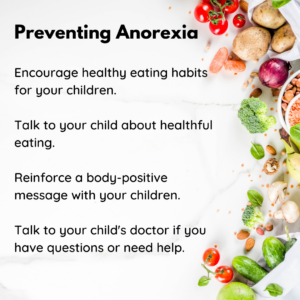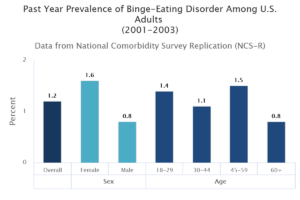Chapter 6: Eating Disorders
Overview
Eating disorders are serious and persistent conditions related to eating behaviors that will negatively impact an individual’s life. Eating disorders typically focus heavily on body weight, shape, and food which ultimately affect the body’s ability to absorb nutrition. These disorders can have a lasting effect on multiple bodily systems like cardiovascular, gastrointestinal, skeletal, and contribute to the other diseases manifestation (Mayo Clinic, 2022). These disorders can be initiated by recurring and distressing thoughts and emotions (American Psychiatric Association, 2022).

Anorexia Nervosa
Criteria to Diagnose: This disorder is characterized by “persistent refusal of food, excessive fear of weight gain, refusal to maintain minimally normal body weight, disturbed perception of body image, and amenorrhea (absence of at least three menstrual periods)” (American Psychological Association, 2022). Individuals with this disorder often engaging excessive body measuring like weights, measuring, and mirror assessments (Black & Grant, 2014). There are high rates of comorbidity and mortality associated with this disorder.
There are two types of anorexia: the restricting type and the binge/purging type. Each are very serious and life threatening conditions, but especial those who engage in purging (American Psychiatric Association, 2022).
Typical Demographics: Individuals that typically experience this disorder are adolescent girls, it can effect any person at any time. Roughly 1% of women are diagnosed with this is .1% of men are diagnosed. This disorder was the first eating disorder identified and seems to be present throughout history (Black and Grant, 2014).
Treatment, Medications, and Therapies: Treatment includes developing health behaviors for eating and weight control. If there are co-occurring disorders, those would also be addressed. Sometimes stress and genetics play a role in this disorder, so preventative methods, details below may be relevant to stop the disorder before it starts (Mayo Clinic, 2022).

Case Studies to Review:
- Secret hunger: The case of Anorexia Nervosa (2021)
- The transition from restrictive anorexia nervosa to binging and purging: A systematic review and meta-analysis (2022)
- A perspective on chronic and long-lasting anorexia nervosa (2021)
Bulimia Nervosa

Criteria to Diagnose: Bulimia Nervosa is characterized by consuming large quantities of food () and then purging the food via vomiting, laxatives, or excessive exercise (Black & Grant, 2014; APA, 2022). Binging occurs at least weekly following by the “compensatory” behaviors (American Psychiatric Association, 2022). Individuals with this disorder will often exhibit these behaviors: frequent bathroom trips after meals, sort throat, swelling of face, tooth decay, acid reflux, diarrhea, excessive use of laxatives or water pills, and feeling light-headed (American Psychiatric Association, 2022).
Like anorexia, individuals typically experience body image distortion and extreme concern for fatness and body shape. The preoccupation with their body image leads to a reduction in self-worth (American Pscyhiatric Association, 2022).
Typical Demographics: The majority of those diagnosed are women, roughly 1% are adolescent women (Black & Grant, 2014); generally these individuals are 18 years of age.

Treatment, Medications, and Therapies: Recommended treatment plans, that are tailored to individual needs, include psychotherapy (individual, group, and/or family), medical care, nutritional counseling, and medications. Antidepressants, specifically Prozac, is the only SSRI approved to be used for this disorder.
Case Studies to Review:
- Case report: Unexpected remission from extreme and enduring bulimia nervosa with repeated ketamine assisted psychotherapy (2021)
- Stigmatization toward people with anorexia nervosa, bulimia nervosa, and binge-eating disorder: A scoping review (2021)
Binge Eating
!["[365] 096" by Corie Howell is licensed under CC BY-NC-ND 2.0.](https://pressbooks.palni.org/psychopathology/wp-content/uploads/sites/34/2022/06/binge-eating1-300x238.jpg)
Criteria to diagnose: Binge-eating disorder is when individuals lose all awareness and control over their eating; often consuming large quantities of food in a two hour span. The difference between this disorder and bulimia nervosa is that the individuals do not complete compensatory behaviors after binging. Therefore, these individuals are often over-weight or obese. Binge-eating is usually characterized by eating large quantities when not hungry, even when uncomfortable; usually eating along and feeling guilty about the episodes (NIMH, 2022). The binge-eating occurs at least once a week (Mayo Clinic, 2022).
Typical Demographics: “Approximately two-thirds of individuals with binge-eating disorder have a history of using inappropriate compensatory behaviors, suggesting a past diagnosis of bulimia nervosa” (Black & Grant, 2014).
Treatment, Medications, and Therapies: National Eating Disorders Association (2022) suggests that roughly 4% of women and 2% of men have had this disorder at some point in their life. It is three times more common than anorexia and bulimia.
Case Studies to Review:
- Stressful life events among individuals with a history of eating disorders: A case-control comparison (2021)
- Binge eating disorder (2022)
References
American Psychiatric Association (2022). What are eating disorders? Retrieved on August 22, 2022 from https://www.psychiatry.org/patients-families/eating-disorders/what-are-eating-disorders
American Psychological Association (2022). Anorexia nervosa. APA. Retrieved on August 22, 2022 from https://dictionary.apa.org/anorexia-nervosa
BBC Three (2018, July 1). Anorexia recovery story: How I survived an eating disorder [Video]. YouTube. https://www.youtube.com/watch?v=aW23gpBx2i8
Black, D. W., & Grant, J. E. (2014). DSM-5® Guidebook : The Essential Companion to the Diagnostic and Statistical Manual of Mental Disorders, Fifth Edition: Vol. Fifth edition. American Psychiatric Association Publishing.
Brelet L, Flaudias V, Désert M, Guillaume S, Llorca P-M, and Boirie Y. (2021). Stigmatization toward People with Anorexia Nervosa, Bulimia Nervosa, and Binge Eating Disorder: A Scoping Review. Nutrients; 13(8):2834. https://doi.org/10.3390/nu13082834
Giordano, S. Secret Hunger: The Case of Anorexia Nervosa. Topoi 40, 545–554 (2021). https://doi.org/10.1007/s11245-020-09718-x
Iqbal A, Rehman A. Binge Eating Disorder. (2022 Jun 5). In: StatPearls [Internet]. Treasure Island (FL): StatPearls Publishing; 2022 Jan-. Available from: https://www.ncbi.nlm.nih.gov/books/NBK551700/
Lie, S.Ø., Bulik, C.M., Andreassen, O.A. et al. (2021). Stressful life events among individuals with a history of eating disorders: a case-control comparison. BMC Psychiatry 21, 501 https://doi.org/10.1186/s12888-021-03499-2
Mayo Clinic (2022). Eating disorders. Diseases and Conditions. Retrieved on August 22, 2022 from https://www.mayoclinic.org/diseases-conditions/eating-disorders/symptoms-causes/syc-20353603
Mayo Clinic (2022). Bulimia disorders. Diagnosis and treatment. Retrieved on August 22, 2022 from https://www.mayoclinic.org/diseases-conditions/bulimia/diagnosis-treatment/drc-20353621
National Institute of Mental Health (2022). Eating disorders. Health Topics. Retrieved on August 22, 2022 from http://Encourage healthy eating habits for your children. Talk to your child about healthful eating. Reinforce a body-positive message with your children. Talk to your child’s doctor if you have questions or need help.
Patient (2018, Feburary 26). What is anorexia nervosa? [Video]. YouTube. https://www.youtube.com/watch?v=aW23gpBx2i8
Ragnhildstveit A, Jackson LK, Cunningham S, Good L, Tanner Q, Roughan M and Henrie-Barrus P (2021) Case Report: Unexpected Remission From Extreme and Enduring Bulimia Nervosa With Repeated Ketamine Assisted Psychotherapy. Front. Psychiatry 12:764112. doi: 10.3389/fpsyt.2021.764112
Serra, R., Di Nicolantonio, C., Di Febo, R. et al. (2022). The transition from restrictive anorexia nervosa to binging and purging: a systematic review and meta-analysis. Eat Weight Disord 27, 857–865. https://doi.org/10.1007/s40519-021-01226-0
Speciani M, Barak Y, Damanhuri H, De Ronchi D, Panariello F and Atti AR (2021). A Perspective on Chronic and Long-Lasting Anorexia Nervosa. Front. Psychiatry 12:756669. doi: 10.3389/fpsyt.2021.756669
Stanford Center for Health Education (2022, May 25). Bulimia: Signs & treatment options [Video]. YouTube. https://www.youtube.com/watch?v=jWTKFX2cPPs
Stanford Center for Health Education (2022, July 14). Binge eating disorder: Recovery begins with compassion [Video]. YouTube. https://www.youtube.com/watch?v=ZfNYQ8n_guY
eating a large amount of food in a short period of time with a loss of control or awareness of what is being consumed (American Psychiatric Association, 2022).

